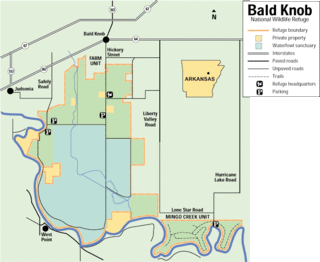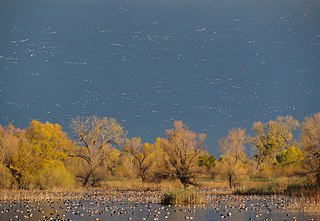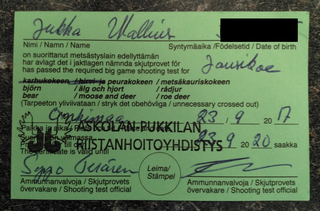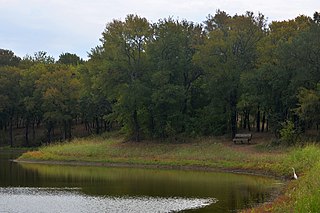
Hunting is the human practice of seeking, pursuing, capturing, and killing wildlife or feral animals. The most common reasons for humans to hunt are to obtain the animal's body for meat and useful animal products, for recreation/taxidermy, although it may also be done for resourceful reasons such as removing predators dangerous to humans or domestic animals, to eliminate pests and nuisance animals that damage crops/livestock/poultry or spread diseases, for trade/tourism, or for ecological conservation against overpopulation and invasive species.

The Bald Knob National Wildlife Refuge is a 15,022 acres (60.79 km2) (2014) wildlife refuge located in White County, Arkansas about two miles south of the town of Bald Knob. The refuge is managed by the United States Fish and Wildlife Service. The refuge features large numbers of migratory waterfowl and bald eagles during the winter months.

A flyway is a flight path used by large numbers of birds while migrating between their breeding grounds and their overwintering quarters. Flyways generally span continents and often pass over oceans. Although applying to any species of migrating bird, the concept was first conceived and applied to waterfowl and shore birds. The flyways can be thought of as wide arterial highways to which the migratory routes of different species are tributaries. An alternative definition is that a flyway is the entire range of a migratory bird, encompassing both its breeding and non-breeding grounds, and the resting and feeding locations it uses while migrating. There are four major north–south flyways in North America and six covering Eurasia, Africa, and Australasia.
The Migratory Bird Treaty Act of 1918 (MBTA), codified at 16 U.S.C. §§ 703–712, is a United States federal law, first enacted in 1918 to implement the convention for the protection of migratory birds between the United States and Canada. The statute makes it unlawful without a waiver to pursue, hunt, take, capture, kill, or sell nearly 1,100 species of birds listed therein as migratory birds. The statute does not discriminate between live or dead birds and also grants full protection to any bird parts, including feathers, eggs, and nests. A March 2020 update of the list decreased the number of species to 1,093.

The Canadian Wildlife Service or CWS, is a Branch of the Department of Environment and Climate Change Canada, a department of the Government of Canada. November 1, 2012 marked the 65th anniversary of the founding of Service.

Shot is a collective term for small spheres or pellets, often made of lead. These have been projected from slings since ancient times and were the original projectiles for shotguns and are still fired primarily from shotguns and grenade launchers, while they are less commonly used in riot guns. Shot shells are also available in many handgun calibers in a configuration known as "birdshot", "rat shot", or "snake shot".

Wildlife management is the management process influencing interactions among and between wildlife, its habitats and people to achieve predefined impacts. It attempts to balance the needs of wildlife with the needs of people using the best available science. Wildlife management can include wildlife conservation, gamekeeping and pest control. Wildlife management draws on disciplines such as mathematics, chemistry, biology, ecology, climatology and geography to gain the best results.

Game laws are statutes which regulate the right to pursue and hunt certain kinds of wild animals and fish. The scope of game laws can include the following:
Legislation on hunting with dogs is in place in many countries around the world. Legislation may regulate, or in some cases prohibit the use of dogs to hunt or flush wild animal species.

Waterfowl hunting is the practice of hunting aquatic birds such as ducks, geese and other waterfowls or shorebirds for sport and meat. Waterfowl are hunted in crop fields where they feed, or in areas with bodies of water such as rivers, lakes, ponds, wetlands, sloughs, or coasts. There are around 3 million waterfowl hunters in the United States alone.

The National Wildlife Refuge System in the United States has a long and distinguished history.

A hunting license or hunting permit is a regulatory or legal mechanism to control hunting, both commercial and recreational. A license specifically made for recreational hunting is sometimes called a game license.
The San Luis National Wildlife Refuge Complex is located in the northern San Joaquin Valley, within Merced County and Stanislaus County of California. The complex, with four federal National Wildlife Refuges, is managed by the U.S Fish & Wildlife Service.

Ottawa National Wildlife Refuge is a National Wildlife Refuge of the United States, which is located in the state of Ohio. This refuge was established in 1961, under the Migratory Bird Conservation Act, the purpose of the refuge being created was “… for use as an inviolate sanctuary, or for any other management purpose, for migratory birds.” 16 U.S.C. 715d. This refuge provides ideal habitat for a wide range for migratory birds and waterfowl, along with the native wildlife, and any endangered and threatened species. The property of the refuge was purchased from hunt clubs and farmlands with the Federal Duck Stamps.

Hagerman National Wildlife Refuge (HNWR), a haven for migratory birds and other wildlife, lies in northwestern Grayson County, Texas, on the Big Mineral Arm of Lake Texoma, on the Red River between Oklahoma and Texas. This National Wildlife Refuge is made up of water, marsh, and upland habitat. Visitors can hike, observe wildlife, hunt, and fish throughout the year.
Sequoyah National Wildlife Refuge was established in 1970 to provide habitat for waterfowl and other migratory birds and to provide food and cover for resident wildlife. It contains 20,800 acres (8,400 ha) on the western edge of Robert S. Kerr Reservoir in three Oklahoma Counties: Muskogee, Haskell and Sequoyah. The refuge was named in honor of Sequoyah, a Cherokee who developed an alphabet for the Cherokee language.
The Louisiana Department of Wildlife and Fisheries (LDWF) is a state agency of Louisiana that maintains state wildlife and fishery areas. The agency is headquartered in the capital city of Baton Rouge.
The Barrow Duck-In was a civil disobedience event that occurred in Utqiaġvik, Alaska, in the spring of 1961. During the Duck-in, the Iñupiat protested a federal hunting ban on ducks, which threatened their livelihood and rights to food security. The Alaskan North Slope is a remote and rural area, and many residents rely on seasonal bird hunts for sustenance. A series of attempts to regulate Iñupiat subsistence by federal and international entities led to the Duck-in, in which over one-hundred Iñupiaq residents of Utqiaġvik protested waterfowl regulations in the area. The Duck-in is considered a seminal protest, as it had significant influence over future subsistence regulation and Native claims laws in Alaska, such as the Alaska Native Claims Settlement Act (ANCSA).
In hunting, take or taking is a term used in the United States to refer to any action that adversely affects a species, particularly killing individuals of that species, as outlined by the United States Endangered Species Act of 1973. Although "taking" most commonly refers to the act of killing animals in a hunting context, its definition can also extend to include harassing, harming, pursuing, hunting, shooting, wounding, trapping, capturing, and collecting any plant or animal. The definition of take can also further extend to comprise the indirect harming of a species via modification of its habitat.

Hunting is a significant subsistence and recreational activity in the United States. Regulation of hunting began in the 19th century. Some modern hunters see themselves as conservationists. American hunting tradition values fair chase, which values the balance between the hunter and the animals. A 2006 poll showed that 78% of Americans support hunting. 6% of Americans have hunted. Hunting is most popular in the Midwest.












